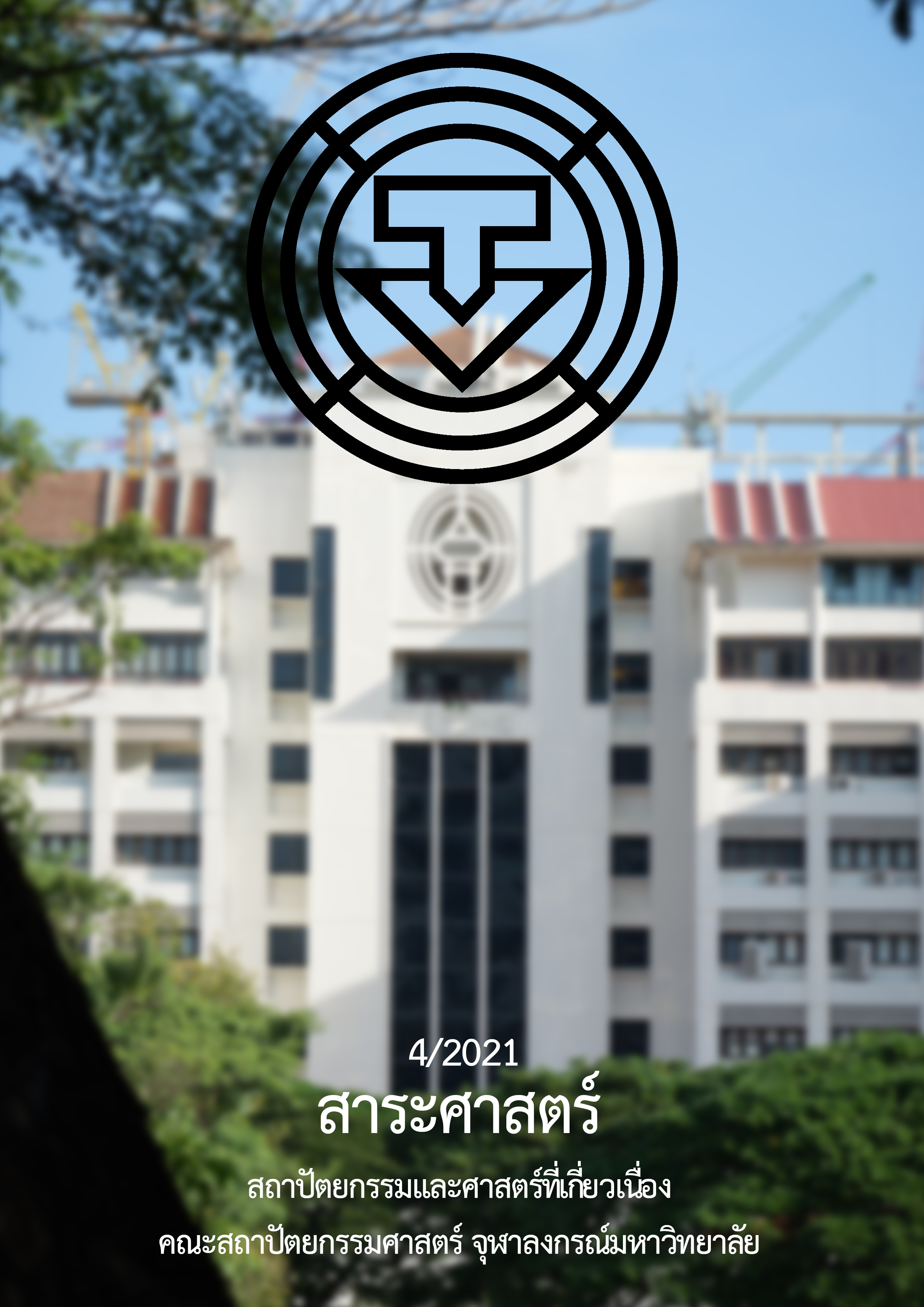แนวทางการส่งเสริมการพัฒนาแหล่งท่องเที่ยวอย่างยั่งยืน ในพื้นที่อนุรักษ์ชุมชนประวัติศาสตร์ : กรณีศึกษาชุมชนอัมพวา จังหวัดสมุทรสงคราม
Main Article Content
บทคัดย่อ
ชุมชนอัมพวาเป็นชุมชนอนุรักษ์ประวัติศาสตร์ที่มีการท่องเที่ยวเป็นส่วนสำคัญในการขับเคลื่อนเศรษฐกิจของชุมชน แต่ในทศวรรษที่ผ่านมาการท่องเที่ยวได้ส่งผลให้เกิดความเปลี่ยนแปลงต่อชุมชน ทั้งในด้านวิถีชีวิตชุมชน เศรษฐกิจและการจ้างงาน และการรักษาสิ่งแวดล้อมทางวัฒนธรรมและทางธรรมชาติ อย่างไรก็ดีกิจกรรมด้านการท่องเที่ยวในพื้นที่เกิดการชะงักตัวจากการแพร่ระบาดของโรคโควิด-19 และพบว่าหน่วยงานที่เกี่ยวข้องในชุมชนอัมพวาได้มีการวางแผนการเปลี่ยนแปลงรูปแบบการท่องเที่ยวในชุมชนให้สามารถก้าวไปสู่ความยั่งยืนในอนาคต บทความฉบับนี้จึงมุ่งเน้นการศึกษาความสำคัญของปัจจัย มาตรการและกลยุทธ์ที่ส่งเสริมการพัฒนาแหล่งท่องเที่ยวอย่างยั่งยืน (Sustainable Tourism Development) ด้วยการสัมภาษณ์ผู้มีส่วนได้ส่วนเสียทั้งภาคประชาชน ผู้เยี่ยมเยือน ภาคเอกชน หน่วยงานภาครัฐ นักวิชาการและผู้เชี่ยวชาญ โดยให้ผู้มีส่วนได้ส่วนเสียทำการเปรียบเทียบความสำคัญแบบคู่ (Pairwise Comparison) ภายใต้กระบวนการวิเคราะห์ตามลำดับชั้น (AHP) เพื่อสะท้อนความคิดเห็นของผู้มีส่วนได้ส่วนเสียต่อการพัฒนาการท่องเที่ยวอย่างยั่งยืนในชุมชนอัมพวา
ผลการศึกษาแสดงให้เห็นว่าผู้มีส่วนได้ส่วนเสียในชุมชนอัมพวาให้ความสำคัญต่อปัจจัยส่งเสริมการพัฒนาแหล่งท่องเที่ยวอย่างยั่งยืนไปในทิศทางที่แตกต่างกันโดยภาคประชาชนและหน่วยงานภาครัฐให้ความสำคัญกับปัจจัยด้านคุณภาพชีวิตของชุมชน และนโยบายการบริหารจัดการและส่งเสริมการท่องเที่ยวเป็นหลัก ในขณะที่นักวิชาการและผู้เชี่ยวชาญรวมถึงภาคเอกชนจะให้ความสำคัญกับปัจจัยด้านมูลค่าทางเศรษฐกิจและโอกาสในการจ้างงาน และผู้เยี่ยมเยือนจะให้ความสำคัญกับปัจจัยด้านความพึงพอใจต่อการท่องเที่ยวและการอนุรักษ์ประวัติศาสตร์และวัฒนธรรมท้องถิ่น แต่อย่างไรก็ดีผู้มีส่วนได้ส่วนเสียมีความคิดเห็นที่สอดคล้องกันว่ามาตรการส่งเสริมการพัฒนา เช่น การให้สิทธิประโยชน์ทางภาษีกับธุรกิจการค้าการบริการและการสนับสนุนงบประมาณเพื่อกระตุ้นการท่องเที่ยวจะเป็นมาตรการที่มีความสำคัญต่อการพัฒนาการท่องเที่ยวในชุมชน นอกจากนั้นการมีส่วนร่วมในการวางแผนการดำเนินการจากทุกภาคส่วนและการบังคับใช้กฎหมายและติดตามประเมินผลการพัฒนาอย่างเข้มงวดจะเป็นกลยุทธ์สำคัญที่สามารถผลักดันให้เกิดการพัฒนาแหล่งท่องเที่ยวอย่างยั่งยืนได้อย่างมีประสิทธิภาพ
Article Details
เอกสารอ้างอิง
กระทรวงการท่องเที่ยวและกีฬา. (2557). ประชุมแนวทาง การพัฒนา 12 จังหวัดท่องเที่ยว "เมืองต้องห้าม...พลาด". สืบค้นจาก https://mots.go.th/content.php?nid=6082&filename=
กระทรวงการท่องเที่ยวและกีฬา. (2562). รายงานฉบับสมบูรณ์ โครงการเพื่อการส่งเสริมการท่องเที่ยวอย่างยั่งยืน. สืบค้นจากhttps://mots.go.th/ewt_dl_link.php?nid=12288
กองบรรณาธิการวอยซ์ออนไลน์. (2560). การท่องเที่ยวแห่งประเทศไทย เปิดตัวโครงการ 12 เมืองต้องห้าม...พลาด Plus ปี 2561. สืบค้นจาก https://voicetv.co.th/read/rkuo2LrlM
คณะกรรมการนโยบายการท่องเที่ยวแห่งชาติ. (2559). เกณฑ์การพัฒนาการท่องเที่ยวโดยชุมชนของประเทศไทย. สืบค้นจากhttps://data.go.th/dataset/bcbd804e-aea8-4d8c-aa72-f87d431d22c6/resource/d4103ef8-e7b6-4540-9c31-d921a8099b8f/download/x-.pdf
คณะกรรมการนโยบายการท่องเที่ยวแห่งชาติ. (2560). เเผนพัฒนาการท่องเที่ยวแห่งชาติ ฉบับที่ ๒ (พ.ศ. ๒๕๖๐ – ๒๕๖๔). สืบค้นจาก https://www.mots.go.th/download/article/article_20170320150102.pdf
ธนัชชา ฤทธิ์เดช. (2558). แนวทางการพัฒนากิจกรรมการท่องเที่ยวและแหล่งท่องเที่ยวให้เกิดความยั่งยืนของตลาดน้ำอัมพวา จังหวัดสมุทรสงคราม. วารสารการบริการและการท่องเที่ยวไทย, 10(2), 18-33.
บุญเลิศ จิตตั้งวัฒนา. (2542). การวางแผนพัฒนาการท่องเที่ยวแบบยั่งยืน (พิมพ์ครั้งที่ 1). เชียงใหม่: คณะมนุษยศาสตร์ มหาวิทยาลัยเชียงใหม่.
พงศ์พนรัตน์ กาญจน์นภา. (2562). มาตรฐานการท่องเที่ยวที่เกี่ยวข้อง Sustainable Tourism Criteria. สืบค้นจาก https://tatskillfactory.tourismthailand.org/uploads/coursetat/document/cover/20200929/bcdfilopy014.pdf
สาธิญา รุ่งพิพัฒนพงศ์. (2557). องค์ประกอบของความยั่งยืนสำหรับการท่องเที่ยวเชิงสร้างสรรค์: กรณีศึกษาชุมชนอัมพวา จังหวัดสมุทรสงคราม. กรุงเทพมหานคร: จุฬาลงกรณ์มหาวิทยาลัย.
สำนักงานจังหวัดสมุทรสงคราม. (2562). แผนพัฒนาจังหวัดสมุทรสงคราม พ.ศ. 2561-2565 (ฉบับทบทวน). สืบค้นจากhttp://www.samutsongkhram.go.th/V2013/attachments/article/7951/1432-3.pdf
สำนักงานจังหวัดสมุทรสงคราม. (2563). คำสั่งจังหวัดสมุทรสงครามที่ 710/2563 เรื่อง ปิดสถานที่เสี่ยงต่อการแพร่ระบาดของโรคติดต่ออันตราย. สืบค้นจากhttp://www.samutsongkhram.go.th/V2013/attachments/article/8969/5-710-2563.pdf
ศิริวรรณ ศิลาพัชรนันท์. (2553). การอนุรักษ์และฟื้นฟูชุมชนอัมพวา. กรุงเทพฯ: ภาควิชาการวางแผนภาคและเมือง คณะสถาปัตยกรรมศาสตร์ จุฬาลงกรณ์มหาวิทยาลัย.
ศราวุธ ผิวแดง. (2558). การพัฒนาการท่องเที่ยวอย่างยั่งยืน Sustainable Tourism Development. อุดรธานี: คณะวิทยาการจัดการมหาวิทยาลัยราชภัฏอุดรธานี.
องค์การบริหารการพัฒนาพื้นที่พิเศษเพื่อการท่องเที่ยวอย่างยั่งยืน (องค์การมหาชน). (2558). Community-based tourism ท่องเที่ยวโดยชุมชน. สืบค้นจาก https://tis.dasta.or.th/dastaknowledge/wp-content/uploads/2018/02/1-Community-Based-Tourism.pdf
อุษาวดี พูลพิพัฒน์. (2545). การท่องเที่ยวแบบยั่งยืน: กรณีศึกษาการท่องเที่ยวเชิงนิเวศโดยชุมชน ในประเทศไทย. จุลสารการท่องเที่ยว, 21(4), 38-48.
อริสรา เสยานนท์. (2552). การป้องกันการเสื่อมโทรมและการอนุรักษ์ทรัพยากรธรรมชาติและสิ่งแวดล้อมของตลาดน้ำอัมพวา. วารสารวิชาการ มหาวิทยาลัยหอการค้าไทย, 29(4), 163-172.
Arnstein, S. (1969). A ladder of citizen participation. Journal of the American Planning Association, 35(4), 216–224.
Byrd, E. T. (2007). Stakeholders in sustainable tourism development and their roles: Applying stakeholder theory to sustainable tourism development. Tourism Review, 62(2), 6-13.
Global Sustainable Tourism Council [GSTC]. (2019). GSTC destination criteria Version 2.0. Retrieved from https://www. gstcouncil. org/wp-content/uploads/GSTC-Destination-Criteria-v2.0.pdf
Landorf, C. (2009). Managing for sustainable tourism: A review of six cultural World Heritage Sites. Journal of Sustainable Tourism, 17(1), 53-70.
Liu, Z. (2003). Sustainable tourism development: A critique. Journal of Sustainable Tourism, 11(6), 459-475.
McIntyre, G. (1993). Sustainable tourism development: Guide for local planners. Geneva: World Tourism Organization (WTO).
Saaty, T. L. (2004). Decision making—The analytic hierarchy and network processes (AHP/ANP). Journal of Systems Science and Systems Engineering, 13(1), 1-35.
Shen, C. C., Chang, Y. R., & Liu, D. J. (2020). Rural tourism and environmental sustainability—A study on a model for assessing the developmental potential of organic agritourism. Sustainability, 12(22), 9642.
Sofield, T. H. (Ed.). (2003). Empowerment for sustainable tourism development. Bingley: Emerald Group Publishing.
Tsaur, S. H., & Wang, C. H. (2007). The evaluation of sustainable tourism development by analytic hierarchy process and fuzzy set theory: An empirical study on the Green Island in Taiwan. Asia Pacific Journal of Tourism Research, 12(2), 127-145.
UNESCO. (2008). Herat old city in Afghanistan and stadium Merdeka in Malaysia win the two awards of excellence in the 2008 UNESCO Asia-Pacific heritage awards. Retrieved from https://bangkok.unesco.org/content/winning-projects
UNWTO. (2005). Sustainable developmentr. Retrieved from https://www.unwto.org/sustainable-development


